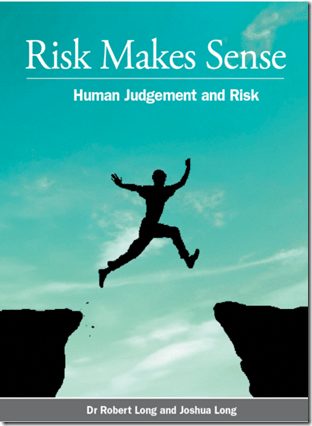Many have read the term “embracing risk” on this blog or seen the “leap of faith” cover on the series of books by Dr Rob Long (see them here) and completely misconstrued the meaning – thinking it implies being fatalistic, reckless or foolhardy. Not so, as Dr Long explains:
Risk as a ‘Leap of Faith’
 All life and living involves a leap of faith (Kierkegaard). We live today and step out tomorrow with unlimited hindsight and very little foresight. This is the nature of human fallibility. The daily leap of faith is the suspension of uncertainty and vulnerability in order to leap into life. We step out into life ‘as if’ all will be well, this is the nature of trust. We have no evidence that all will be well, we must believe all will be well, or we wouldn’t get out of bed. It is this trust that makes all tackling of risk ‘a social-psychological quasi-religious faith’ (Giddens, Simmel and Mollering). The writer of the Hebrews put it succinctly: ‘faith is the substance of things hoped for, the evidence of things not seen’. To trust is to act ‘as if’ the uncertain future actions of others are certain.
All life and living involves a leap of faith (Kierkegaard). We live today and step out tomorrow with unlimited hindsight and very little foresight. This is the nature of human fallibility. The daily leap of faith is the suspension of uncertainty and vulnerability in order to leap into life. We step out into life ‘as if’ all will be well, this is the nature of trust. We have no evidence that all will be well, we must believe all will be well, or we wouldn’t get out of bed. It is this trust that makes all tackling of risk ‘a social-psychological quasi-religious faith’ (Giddens, Simmel and Mollering). The writer of the Hebrews put it succinctly: ‘faith is the substance of things hoped for, the evidence of things not seen’. To trust is to act ‘as if’ the uncertain future actions of others are certain.
Faith and hope symbolize a bond that reaches out beyond uncertainty and helps us suspend doubt and tackle the unknowns of the physical realm. If humans had complete knowledge (optimizing) or were completely ignorant there would be no need for trust. Rather, humans have incomplete knowledge and so ‘satisfice’ in decision making based on trust. This idea of suspension of doubt is critical when tackling risk. James and Weick call this suspension ‘bracketing’. It denotes a temporary ‘blending out’ so that uncertainty and fallibility don’t stall the need to live in the world where wheels fall off and things go bump, the nature of emergent randomness.
Humans always make decisions with partial knowledge (satisficing). A risk assessment is at best an approximation and expectation but most by-products and trade-offs (https://safetyrisk.net/risk-and-safety-matrices-and-the-psychology-of-colour/) associated with our decisions are not known. If they were known we would indeed be gods and omniscient.
Getting married or bonding with another in relationship is always based on a ‘leap of faith’ and trust. Marriage is one of those great risks many take with incomplete knowledge and little preparedness for the turbulence approaching. But we take the risk in love, believing the best. Trust does not rest on objective certainty but on this believed illusion. We enter relationships on the fiction of social certainty and invulnerability.
I remember when driving taxis on Friday and Saturday nights that I had some indicators and cues that lessened my trust. Unfortunately, these are only indicators. On several occasions things went pear-shaped. I had ‘runners’, people with mental health issues and violence all committed by well-dressed people with a calm demeanour. I remember once two blokes in suits who at 2am filled the back floor with vomit that I hosed out with a fire hose at a service station and they threatened to harm me and so didn’t pay. On occasions I felt highly at-risk. I have had a similar feeling when in maximum security in a correctional centre. In such moments, one fears for their life, all is uncertain, there is no foundation for trust. Trust is betrayed.
Trust gives us what Erikson (1965) called ‘ontological security’. A security of being in the face of risk, even the risk of death. This is what allows people to undertake ‘edgework’ (work on the edge of risk). Something I discussed in my first book. When we work in risk we often seek confirmation (evidence-seeking) that all will be well. We weigh up the indicators based on past experience (heuristics) and trust to move forward even in the face of ambiguity. This is the nature of ‘bracketing’ and ‘suspension’. In such a state we treat uncertainty and vulnerability as unproblematic. This allows us to continue in our ‘leap of faith’.
No wonder then that in the face of such quasi-religious social psychology that those seeking absolute certainty enter into a discourse of fundamentalism. Seeking absolutes when there are none. Seeking ‘controls’ when in a state of faith. In this alternative faith the fundamentalist shelters behind cardinal (religious) rules and the aspiration (es spiritus sancti) of zero harm. It is here in the Du Pont Bradley Curve (https://safetyrisk.net/sexy-curves-and-the-paradox-of-risk/ ) that one learns that human instincts are problematic as originally given (original sin). This is where the ‘choice’ for unsafety is equated with evil. So in the search for zero harm we now invent ‘drops calculators’ and eugenic diagnostics to caste out sinners (https://safetyrisk.net/safety-just-a-few-bad-apples/) (https://safetyrisk.net/safety-eugenics-and-the-engineering-of-risk-aversion/ ). Then the closer Safety gets to zero injury rates the closer humans (apparently) get to perfection. Sounds like a lot of faith and trust to me.



Do you have any thoughts? Please share them below